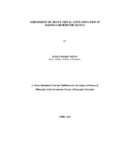ASSESSMENT OF HEAVY METAL CONTAMINATION IN MASINGA RESERVOIR, KENYA
Abstract
In Kenya, monitoring of heavy metal pollution is a priority area of research since their concentrations in aquatic ecosystems affect the fish industry which is a major source of livelihood.Therefore, an assessment of heavy metal contamination (Cu, Zn, Pb, Cr, Mn and Cd) in sediments, water and in three selected fish species (Cyprinus carpio, Clarius gariepinusandOreochromis spirulusniger)in Masinga reservoir was carried out between January and December 2013 in five sampling sites. Physical parameters (water temperature, dissolved oxygen, pH, turbidity and electrical conductivity) were measured on site. Heavy metal Concentrations were determined using atomic absorption spectrophotometry. The data obtained was analyzed using one way analysis of variance and significant differences accepted at p ≤ 0.05. Tukey’s HSD test was used to separate means. The mean values for the physical parameters ranged from 24.93 –27.530C (water temperature), 4.66 -5.36 mgL-1(DO), 41.50 –64.23NTU (Turbidity), 109.79 –125.98μS cm-1(EC) and 7.51 –7.88 (pH). The results revealed significant difference only in water temperature (p =0.044). Mean heavy metal concentrations (mg kg-1) in sediments were Cu (11.38 –23.67), Zn (60.04 –75.84), Pb (11.14 –14.47), Cr (21.39-49.62) and Mn (259.12 –642.30). There were significant differences in metal concentrations for Cu (p =0.00), Cr (p=0.00) and Mn (p=0.00) among the sites. Surface water from different sites did not show significant differences in heavy metal contamination (p > 0.05). The mean metal levels (mg kg-1) in Cyprinus carpiomuscle tissues were in the range of Cu (0.519 –1.422), Zn (39.466 –62.233), Pb (0.994 –1.424), Cr (0.324 –0.709) and Mn (0.660 –1.432). There was significant difference in Zn (p=0.006) and Mn (p=0.001) in Cyprinus carpiomuscles at different sites. In Clarias gariepinusmuscles, mean metal concentrations (mg kg-1) were Cu (0.677 –0.974), Zn (32.929 –37.205), Pb (0.643 –0.078), Cr (0.516 –0.858) and Mn (0.452 –0.990). Pb exhibited significance difference between the sites (p=0.026). Mean values for heavy metals in Tilapia (mg kg-1) for different sites were Cu (0.515 –0.782), Zn (29.645 –37.999), Pb (0.552 –0.765), Cr (0.559 –0.791) and Mn (0.183 –1.480). Only Mn showed significant differences between the sites (p=0.00). Pearson matrix correlation analysis showed some significant correlations among the heavy metal levels in water, sediments and different fish species. Bio accumulation transfer factor (TF) calculated showed that water had higher TF compared to sediments. The concentrations for all metals in surface water did not exceed the WHO recommended limit for drinking water. In sediments and the three fish species they were also lower than WHO set limit except for Cr.Results from this study demonstrate the need for an ecosystem approach towards sustainable management of reservoirs. This will curb aquatic pollution which is a health risk to people consuming aquatic resources contaminated with heavy metals.
Collections
- MKSU Doctoral Theses [51]

